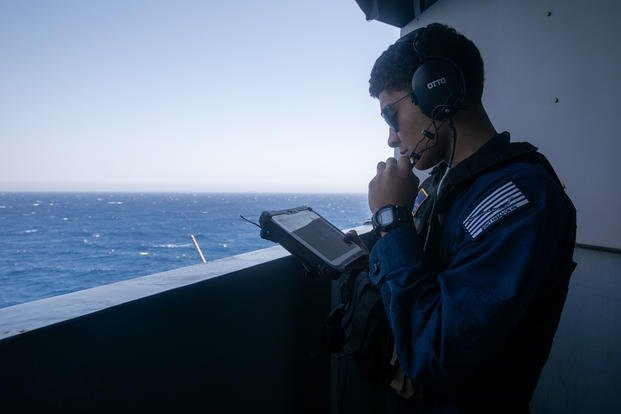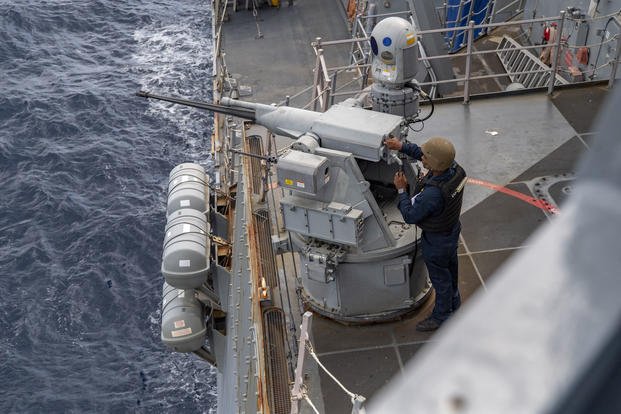The Navy's campaign against Houthi militants exposed a serious deficiency as America's fleet lacks the missiles to sustain combat while preparing for a potential war with China and other adversaries.
Between October 2023 and January 2025, Navy ships fired more defensive missiles at incoming Houthi drones and rockets than they used in three decades following Desert Storm. They also launched hundreds of offensive strike missiles at Houthi positions in Yemen.
The Dwight D. Eisenhower Carrier Strike Group alone fired 155 missiles defending against attacks and 135 Tomahawk cruise missiles striking enemy targets during its deployment from November 2023 to June 2024.
“We're at a dangerously low level from a stockpile perspective,” Navy Secretary John Phelan told senators during his confirmation hearing back in February, pledging to tackle the shortage immediately.
Production Can't Keep Pace With the Navy's Combat
The Navy's entire fleet has about 10,000 vertical launch platforms that fire these missiles. But the service doesn't have enough missiles left in inventory to fill those cells even once.
Through 2023, the U.S. procured roughly 12,000 SM-2s, 400 SM-3s, 1,500 SM-6s, and 9,000 Tomahawks since these weapons entered service, according to The Heritage Foundation. But at least 2,800 Standard Missiles and 2,900 Tomahawks have been expended across various operations over the years — and many more have been retired, used in training, or reached the end of their service lives.
Current production rates mean the shortage will persist. Pentagon documents show the Navy bought 68 Tomahawks in fiscal year 2023, 34 in 2024, with plans for 22 through 2025 and 57 in 2026.
Operation Iraqi Freedom's opening salvoes used roughly 800 Tomahawks. Replacing that expenditure would take over a decade at today’s rates.
Fluctuating Navy orders have created unstable production lines and deterred manufacturers from expanding their capacity. Each Tomahawk requires up to two years to build due to specialized components and limited suppliers for parts like rocket motors.

The China Problem
Retired Navy Cmdr. Bryan Clark of the Hudson Institute warned in Congressional testimony that current missile depletion puts the Navy in a bad position if a conflict with China materialized today.
The Red Sea operations utilized over $1 billion in munitions defending shipping lanes against a non-peer adversary. China's People's Liberation Army Navy operates advanced anti-ship missiles, hypersonic weapons and massive drone swarms that would demand a much larger number of defense systems.
An outbreak of hostilities with China would increase the missile usage rate to a magnitude well over Red Sea levels, further depleting the Navy’s already diminished stockpile.
Several ships recently adapted their defense tactics to preserve the limited stocks of munitions. By mid-2024, the Navy shifted to Sidewinders and Hellfires for drone defense instead of multimillion-dollar Standard Missiles. Crews also employed 5-inch deck guns to protect the vessels from drone threats.
Defense contractors are responding. Raytheon invested over $115 million to increase Standard Missile production capacity by 67 percent at its Huntsville, Alabama, facility. The company also invested $53 million to improve its Lower Tier Air and Missile Defense Sensor (LTAMDS) facility in Massachusetts. Meanwhile, Northrop Grumman opened a facility in West Virginia capable of producing 300 strike missiles annually.
The Navy also announced plans for a Naval Modular Missile program using common components to boost manufacturing efficiency.
Congress has also allocated funds to help these initiatives. An April 2025 defense bill included $4.5 billion for munitions industrial base grants and $200 million for solid rocket motor infrastructure.
But these investments will require years before they are ready while overseas threats demand immediate readiness.

Strategic Calculations
America's military dominance over last few decades led to the assumption that future conflicts would be short and decisive, not grinding campaigns of attrition. The Houthi attacks in the Red Sea challenged that thinking.
The USS Carney spent 10 hours on Oct. 19, 2023, shooting down 15 drones and four cruise missiles — what the Navy called “the most intense combat engagement by a U.S. Navy warship since WWII.” The ship faced 51 engagements during its entire deployment.
That sustained tempo, repeated across multiple ships for over a year, depleted missile stocks that were built over decades.
Pentagon planners now face the reality that the Navy must simultaneously defend global commerce, deter China, support operations in multiple theaters while rebuilding its depleted inventories — all while production capacity remains inadequate.
Former Navy Secretary Carlos Del Toro told the Senate Appropriations Committee in April 2024 the service needed more than $2 billion just to replace Red Sea expenditures. That doesn't account for future missions or strategic reserves for operations in the Pacific.
The Houthi campaign showed that the fleet can fight effectively through tactical adaptation and crew proficiency. But proficiency alone cannot replace vital munitions when facing a peer adversary with an industrial capacity 200 times larger than America's shipbuilding capabilities.
Until production capacity matches operational demands, every missile fired at enemy drones is one fewer available to deter Beijing or other peer adversaries.















